Best East-Facing Window Plants
It’s important to know the type, amount, and intensity of light coming through your window. This will help you select the best east-facing window plants. The number of hours of sunlight and the intensity of sunlight varies based on the direction of your window. This is due to Earth rotating on its axis and orbiting the sun. The North Pole is tilted toward the sun during the summer resulting in warmer temperatures and longer hours of sunlight.
Sunlight in an East Facing Window.
In the northern hemisphere, the sun rises in the east. So you get direct sunlight through your east-facing window. The morning sunlight is thought to be less intense than midday or afternoon. In terms of window direction, east-facing windows get more sun than a north-facing windows but less than south or west-facing window. Sciencing has a great article Sun Intensity vs. Angle that does a great job explaining this concept. If your window is northeast the light may be less intense and southeast may be more intense.
Other Factors Affecting Light to Your East Facing Window Plants.
There may be trees, plants, buildings, or other structures that reduce the amount of light coming through your window. You also need to consider things obstructing the inside of your windows such as blinds or curtains. Will you remember to raise your blinds every day for your plant? Do you have a sheer curtain you want to leave hanging all the time?
You can also enhance or supplement light in your house. You can use a mirror to reflect the sunlight coming through your window and back toward your plant. White surfaces like a dresser or a cabinet reflect light as well. You can also set up grow lights if you want to seriously increase the amount of light your plant gets.
What Are the Best Plants for an East Facing Window?
East-facing windows get some direct morning sun. You also need to assess other factors affecting the light from your east-facing window. You want to stick with plants that characterize their light requirements as “bright indirect light” or “partial shade.” The sun will not be shining directly through your east window for very many hours, most of the day the plant will get indirect light.
Philodendron
Philodendrons come in a variety of leaf colors and patterns. Popular varieties are the heart leaf (with green leaves), brasil (with yellow and green leaves), and lemon lime (with yellow-green leaves). These plants grow fast. Who doesn’t love the thrill of a new leaf?
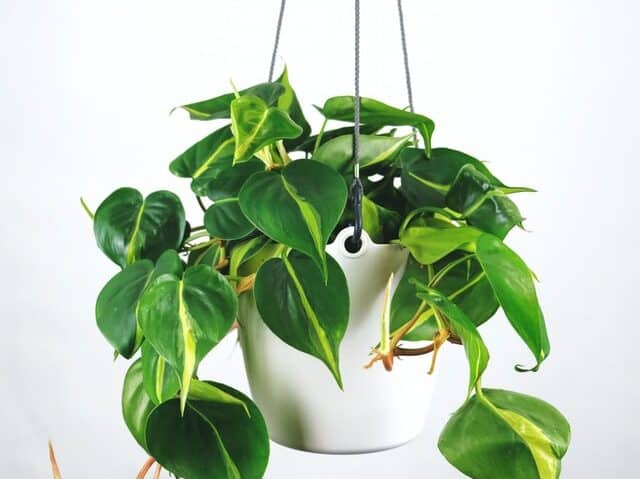
| Light | Water | Soil | Fertilizer |
| Moderate to bright indirect light. | Top inch should be dry before watering. | Well draining potting soil. | A few times per growing season. |
Philodendrons are mostly vining or trailing plants. They can grow fairly long. They are toxic to cats and dogs. The sap, or liquid you see when breaking a stem or leaf, may be a mild skin irritant to some.
Alocasia
Alocasias come in many varieties. This plant will add more than just some green to your east-facing window decor. These plants typically have long stems with large bold leaves. The leaves come in many shapes, colors, and color patterns. Their foliage is something to behold.
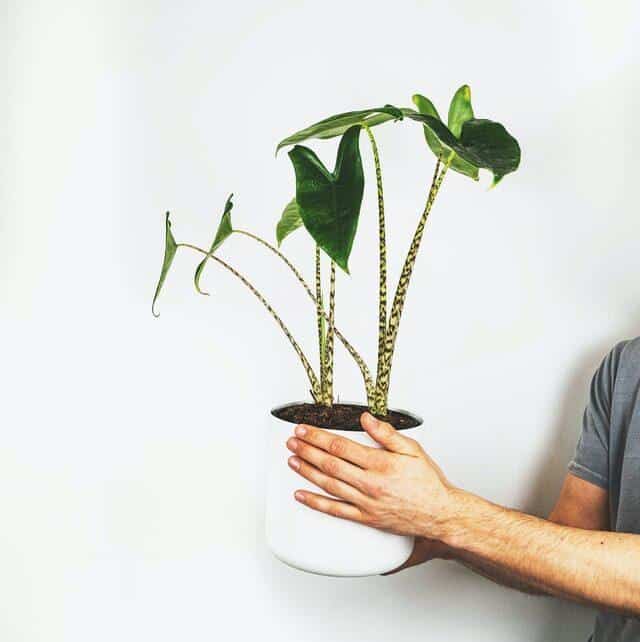
| Light | Water | Soil | Fertilizer |
| Bright indirect light. | Keep soil moist but not soggy. | Well draining potting soil. | Every 2- 4 weeks duriing the growing season. |
Some varieties of alocasia can get over two feet. Alocasias are considered fast growers. They are toxic to cats and dogs. The sap, or liquid you see when breaking a stem or leaf, may be a mild skin irritant to some.
Parlor Palm
Parlor Palms look like compact palm trees. They are considered to be easy to care for and have been a popular indoor plant for a long time. Parlor Palms add a lot of leafy green to your decor. These plants will do well in an east-facing window. They are considered slow growers so get one that’s the size you already want. Parlor Palms should be easy to come by as home improvement stores often have them in stock.
| Light | Water | Soil | Fertilizer |
| Bright indirect light. Tolerates low light. | Top inch should be dry before watering. | Well draining potting soil. | Monthly during the growing season. |
Parlor Palms can grow to about 3 to 4 feet tall. They are not toxic to cats and dogs.
Polka Dot Begonia
Polka Dot Begonias are beautiful foliage plants. Their leaves come in an angel wing shape. The leaves are dark green with silvery polka dots and the underside is a deep red. If you are looking for something interesting to add to your east-facing window, polka dot begonia is it.
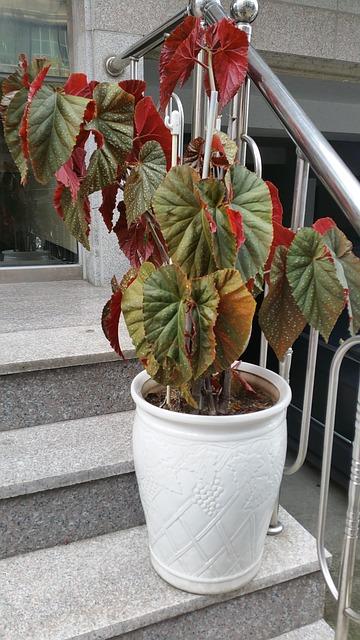
| Light | Water | Soil | Fertilizer |
| Bright to moderate direct light. | Keep soil moist but not soggy. | Well draining potting soil. | Monthly during the growing season. |
Polka Dot Begonias generally stay under two feet tall and they are considered fast growers. They are toxic to cats and dogs. The sap, or liquid you see when breaking a stem or leaf, may be a mild skin irritant to some.
Rubber Tree
Rubber Trees have very thick glossy leaves. The leaves come in many colors. Some of the most popular color varieties are burgundy, tineke (which is various shades of green and cream), and tricolor (which is green, pink, and white). These houseplants are grown as bushes and taller trees. If you’re looking to pick one up quickly, the burgundy variety is often sold at home improvement stores. These houseplants are considered easy to grow. Whatever variety you choose will add an interesting touch to your east-facing window.
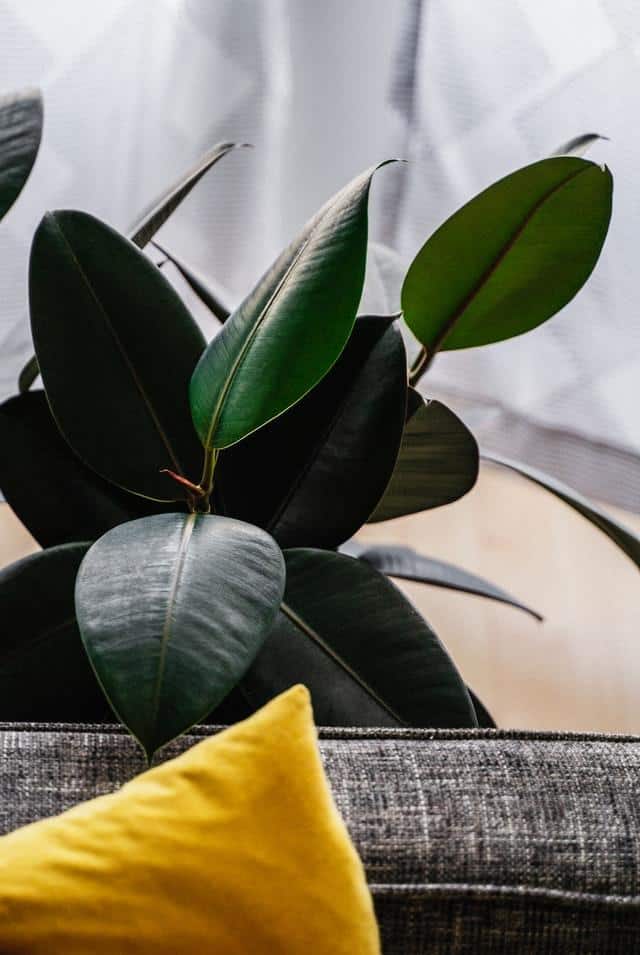
| Light | Water | Soil | Fertilizer |
| Moderate to bright indirect light. | Top inch should be dry before watering. | Well draining potting soil. | Every 2- 4 weeks during the growing season. |
Rubber Trees can grow to be several feet tall indoors. They are slow growers. They are toxic to cats and dogs. The sap, or liquid you see when breaking a stem or leaf, may be a mild skin irritant to some.
Anthurium
I had to include at least one flowing plant in my east-facing window recommendations. Anthuriums have unique waxy-like flowers. The flowers come in a variety of colors such as red, pink, green, purple, and white. These flowers last a long time, two to three months. They can keep flowers all year round if cared for correctly. Anthuriums do well as an east-facing window plant.
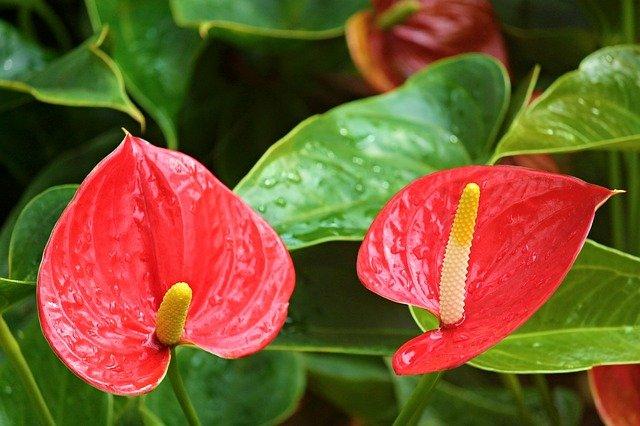
| Light | Water | Soil | Fertilizer |
| Bright indirect light. Tolerates low light. | Keep soil moist but not soggy. | Well draining potting soil. | A few times per growing season. |
These houseplants will stay under two feet tall. Anthruiums grow at a moderate rate. They are toxic to cats and dogs. The sap, or liquid you see when breaking a stem or leaf, may be a mild skin irritant to some.
What other indoor plants do you have hanging out in your east-facing windows? Share in the comments. If you're looking for plant recommendations for other window directions, check out my post on north-facing windows, south-facing windows, and west-facing windows.
Add new comment